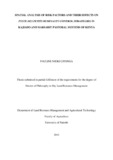| dc.description.abstract | The contribution of sheep and goats to pastoralist livelihoods and economies is limited by the frequent occurrence of small ruminant diseases such as Peste des Petits Ruminants (PPR). PPR, also known as ‘goat plague’, is a highly contagious viral disease of sheep and goats characterised by sudden onset of depression, bilateral eye and nasal discharges, mouth sores , pneumonia, foul-smelling diarrhoea and death. In susceptible small ruminant herds, PPR virus infections result in high morbidity rates of 90 percent (%) and mortality rates of 70%. The disease is endemic across 70 countries in Africa, the Middle East and Southern Asia. Current global estimates indicate that PPR outbreaks in endemic countries results in an annual loss of close to 2 billion United State Dollar (USD). PPR was first introduced into Kenya in 2006, but despite vaccination control measures being in place, the disease has continued to spread and is now endemic throughout Northern Kenya. The underlying risk factors triggering outbreaks in Kenya are not well understood. A risk based cross-sectional study was therefore undertaken with an overall aim of improving the management of PPR disease in small ruminant pastoral production systems in Kenya. The study was carried out between January 2014 and March 2015 in Kajiado county which is a high risk PPR zone and Marsabit county which is an endemic PPR zone.
The study used integrated approaches of questionnaire survey, laboratory and spatial statistical analysis to address three specific objectives, the first objective, characterised small ruminant disease control practices amongst Kajiado and Marsabit pastoral communities. The second, determined the seroprevalence of antibodies against PPR virus as well as the prevalence of intestinal parasites of sheep and goat herds in the study areas. The third, identified risk factors and their effects on PPR control strategies using spatial statistical techniques of a geographical information system (GIS). | en_US |

